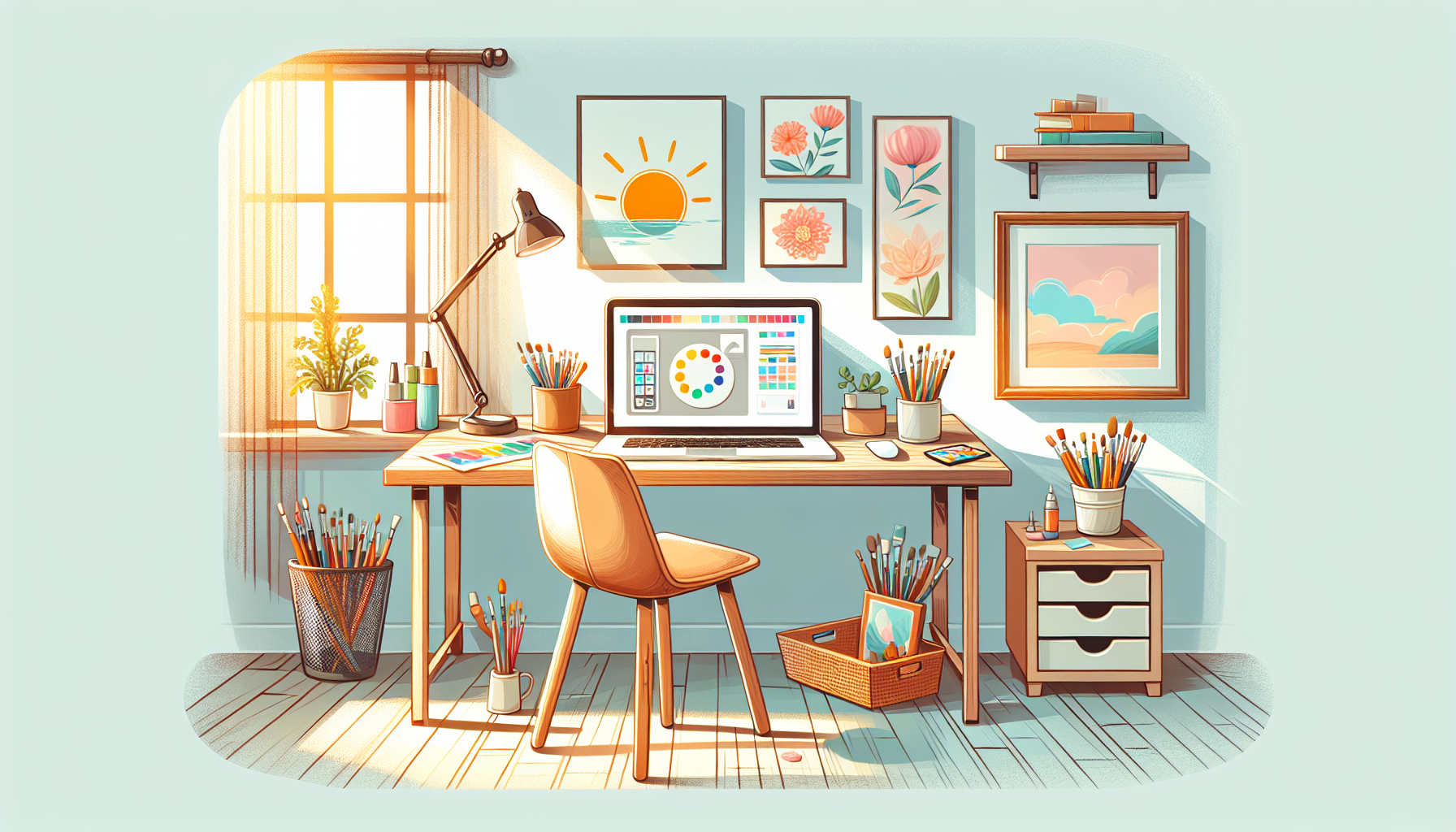Teaching art online can feel overwhelming, right? With technology and endless platforms, it might seem like you need a degree in digital wizardry just to get started. Don’t worry; you’re not alone in feeling this way!
If you stick around, I promise you’ll find the tips and tricks to make online art teaching a breeze. From choosing the right format to fostering student interaction, we’ll cover everything you need to succeed and enjoy the process.
We’ll explore the best practices for setting up your classes, engaging with students, and even making some money along the way! Let’s dive in and turn those online art dreams into reality!
Key Takeaways
- Choose the right format for your online art classes: live streaming or pre-recorded sessions based on your audience.
- Invest in essential equipment such as a quality camera, good microphone, and stable internet for smooth teaching.
- Select a reliable platform like Zoom or Google Meet to host your classes effectively.
- Create an organized syllabus outlining course objectives, projects, deadlines, and assessment methods.
- Prepare all necessary materials in advance, including PDFs and resource folders for student access.
- Run live classes by engaging students, pacing the lessons, and incorporating breaks to maintain focus.
- Use social media and email marketing to promote your classes and attract students.
- Encourage student interaction through group discussions, portfolio sharing, and timely feedback.
- Enhance classes with additional resources like articles, tutorials, and podcasts for deeper learning.
- Monetize effectively by setting clear pricing, offering bundles, and using easy payment methods.
- Prepare for challenges like technical issues and student engagement by being proactive and seeking feedback.
Stefan’s Audio Takeaway

1. Start by Choosing the Right Format for Your Online Art Classes
When setting up online art classes, the first step is to pick a format that suits both you and your students.
This can be live streaming, pre-recorded sessions, or a combination of both.
Live streaming classes like those on Zoom or Google Meet allow you to interact with students in real time, enhancing their learning experience.
On the other hand, pre-recorded videos give you the chance to edit and polish your content, making it more engaging.
Consider what art forms you’ll be teaching; for instance, painting may benefit from live demos, while digital art might work well with recorded tutorials.
Also, think about your audience. Are they beginners looking for a step-by-step guide? Or more advanced students wanting to refine their skills?
Your choice of format can significantly affect student satisfaction and engagement, so take your time to evaluate your options.
2. Set Up Essential Equipment for Teaching Art Online
Before you start teaching, it’s crucial to have the right equipment that makes your online classes smooth and enjoyable.
At the very least, you’ll need a good quality camera that captures your artwork clearly. A webcam or even a smartphone can work wonders.
Investing in a ring light can enhance your video quality by illuminating your workspace effectively.
Don’t forget about your audio setup. Clear sound is vital, so consider using a good microphone to avoid frustrating sound issues.
Having a stable internet connection is also a game-changer; fiber optic or high-speed connections are ideal.
Lastly, make sure your workspace is organized and visually appealing—think about the background seen in your video. A clutter-free space not only looks professional but also enhances focus for your students.
3. Select a Reliable Platform for Hosting Live Classes
Your choice of platform can make or break your online art classes, so it’s essential to pick one that fits your needs.
For small classes, both Zoom and Google Meet offer free plans that allow up to 100 participants.
With Zoom, you can host meetings up to 40 minutes on the free plan, while Google Meet extends that to 60 minutes, which can be helpful for longer sessions.
If you’re planning to run longer classes, consider their premium plans; Zoom starts at $14.99 per month, and Google Meet’s premium features begin at $10.
Think about your teaching style—Zoom allows for breakout rooms, which can be great for group activities.
Test the platforms beforehand to ensure you’re comfortable using the tools and features they offer.

4. Create an Organized Class Syllabus and Schedule
An organized syllabus is key to guiding your students through the learning process.
Start by outlining the course objectives and what students can expect to learn each week.
Include specific projects or assignments so students know what they’ll be expected to produce.
Be clear about deadlines and how you will assess student performance for fairness.
Consider using online tools like [Trello](https://trello.com) for project management to keep everything on track.
Also, factor in time for student breaks and personal reflection—this will help maintain enthusiasm for the art.
A well-structured syllabus helps students feel more organized and engaged.
5. Prepare Materials for Your Students in Advance
Preparation is half the battle when it comes to teaching art online.
Gather all necessary materials ahead of time to avoid hiccups during class.
Prepare PDFs of reference images or videos that students can access easily.
Consider creating a shared Google Drive folder for easy access to resources.
If you’re teaching traditional art techniques, ensure students have the right supplies—brushes, paints, canvases, etc.
If you’re exploring digital art, clear instructions on software installation are a must.
The more you prepare, the smoother your classes will run.
6. Conduct Live Art Classes Effectively
Running live art classes means bringing your best game to the virtual platform.
Start by introducing yourself and the day’s agenda to set the tone.
Encourage students to share their expectations for the class; it fosters engagement.
Use screen sharing to demonstrate techniques or show your work process on your canvas.
Keep the pace steady—make sure to check in regularly to see if students are following along.
Remember to include breaks because staring at a screen can be tiring.
Finally, practice your lessons beforehand to get comfortable with the flow and tech setup.
7. Market Your Online Art Classes to Attract Students
Marketing is essential to filling up your online art classes.
Use social media platforms to showcase your work and tease upcoming classes.
Consider creating short teaser videos to let potential students know what to expect.
Email newsletters can keep your audience updated on class schedules and new offerings.
Don’t forget about leveraging customer testimonials—positive reviews are gold!
You can also collaborate with local art galleries for cross-promotion opportunities.
Offering limited-time discounts or free trial classes can also entice new students.
8. Foster Student Interaction and Provide Helpful Feedback
Interaction is a game changer in online learning; it builds community.
Create breakout sessions where students can discuss their work in small groups.
Encourage sharing of progress, and remind everyone that constructive criticism is valuable!
As an instructor, giving timely and specific feedback helps students know where they stand.
Consider employing tools like [Padlet](https://padlet.com) for sharing portfolios and receiving peer feedback.
Interaction helps students feel less isolated, making learning more enjoyable.
9. Enhance Your Online Teaching with Additional Resources
To enrich your online art classes, consider using supplemental resources.
Creating a resource library with links to articles and videos can enhance the learning experience.
Utilize platforms like [YouTube](https://youtube.com) for inspiring tutorials that students can watch at their own pace.
If using art software, offering links to comprehensive guides or software tutorials can minimize tech struggles.
Books or podcasts relevant to the topics you cover are also excellent for deeper learning.
Your goal is to provide students with multiple avenues to explore their creativity.
10. Monetize Your Online Art Classes Successfully
When it comes to monetizing your online classes, there are several strategies to consider.
Setting clear pricing structures is essential, whether via one-time payments or subscriptions.
Offer tiered classes that allow for advanced levels at increased rates.
Utilizing a user-friendly payment platform can simplify the process for both you and your students.
Additionally, consider bundling classes or offering workshops at a discounted rate.
Promoting exclusive content or members-only events can encourage subscriptions as well.
11. Address Common Challenges in Online Art Teaching
Teaching art online comes with its own set of challenges that you need to be prepared for.
Technical issues can arise anytime, so ensure you’re well-versed in troubleshooting common problems.
Student engagement may wane, so keep lessons dynamic and interactive to hold their attention.
Make it a point to provide support for students who struggle with technology.
Finally, continuously seek feedback after classes to identify and address pain points.
FAQs
Essential equipment includes a good quality webcam, microphone, lighting, and a stable internet connection. Additionally, you may want to use drawing tablets or digital software depending on your class format.
Utilize social media platforms, create compelling content showcasing your art, and offer free trial classes. Collaborating with influencers and running targeted ads can also effectively increase visibility and attract students.
Popular platforms include Zoom, Google Meet, and Microsoft Teams for live classes. These platforms offer features like screen sharing, breakout rooms, and recording options, making them suitable for art instruction.
Offer specific, constructive feedback focused on both strengths and areas for improvement. Use positive reinforcement and encourage open dialogue, allowing students to ask questions about their work.
